Tridentnav Systems navigeringsprogram Tridentnav ECS kan nu konfigureras för att ta in AIS-information via TCP/IP. Programmet kan därmed läsa AIS-data via en vanlig nätverksanslutning, som komplement till den information som fås från AIS-transponder eller mottagare via serieport. Funktionen används just nu till att följa deltagarna i Volvo Ocean Race.
AIS (Automatic Identification System) är ett transpondersystem där fartyg till sjöss över VHF-radio automatiskt skickar sin position mm till andra fartyg i närheten för att underlätta navigeringen och undvika kollisioner.
Möjligheten att ta in AIS-information via TCP/IP i Tridentnav Systems navigeringsprogram kan användas för anslutning över internet till en AIS-server. Programmet kan då följa hundratals AIS-mål beroende på vilket data servern levererar. De parametrar som behövs är IP-adress eller servernamn och TCP-port-nummer, samt eventuellt användarnamn och lösenord för anslutningen.
Just nu används AIS-information via TCP/IP i Tridentnav ECS i samarbete med True Heading för att följa deltagarna i seglingstävlingen Volvo Ocean Race på en storbildsskärm på Seglarhotellet i Sandhamn. Installationen i Sandhamn kommer även att användas för att följa båtarna under den kommande tävlingen Gotland runt.
Mer information om Tridentnav Systems navigeringsprogram och demoversion för nerladdning finns på hemsidan: http://www.tridentnav.se
När det svenska filmbolaget Edinim Produktion AB startade i juni 2002 var motgångarna flera. Lågkonjunkturen hade nått sin botten, överetableringen på filmmarknaden var fullständig och den ihoplånade kassan ständigt på minus. Regissören och initiativtagaren Jonatan Kruse hade inga filmer i sikte, bara problem, avslag och motgångar.
Idag, en konjukturcykel senare, avlöser kunderna varandra, och företagets filmer visas över hela världen.
När Volvo Ocean Race-båtarna anländer Stockholm går även företagets största film hitttills i mål. Reklamfilmen “Stop Over Stockholm” har följt båtarnas färd och visats runt om i världen för över 500 miljoner TV-tittare!
– En gång satte vi orden “Min idé” baklänges, hyrde en stinkande källarlokal på söder och drog igång, säger Jonatan Kruse. Idag har det gått en konjunkturcykel och vi börjar få en världspublik. Med “Stop Over Stockholm” firar vi får största filmseger hittills!
Länk: www.edinim.se
Första gången de seglade tillsammans var i måndags. De vann grundserien och kom tvåa i sin semifinal. De ledde finalen från start till mål. Emil Malmström, Charlie Ekberg Ehnlund och Oscar Mark från Uppsala KF vann Ericsson Jr Cup. – I grundserien har vi först och främst seglat safe, målsättningen har hela tiden varit att gå vidare. Där har vi inte chansat utan hela tiden gått på säkerhet, berättar skeppare Emil Malmström.
– Men i finalen vågade vi satsa lite mer. Där är det mer allt eller inget som gäller, skjuter Charlie Ekberg Ehnlund in.
Emil Malmström, 19 år, seglar 470 i ungdomslandslaget och Charlie Ekberg Ehnlund, 19 år, seglar 49er, men gör gärna gästspel i andra klasser när tillfälle ges. Med sig i besättningen har de Oscar Mark, 10 år, som har seglat optimist i två år.
– Det känns tryggt att ha Oscar med. Det är en lugn kille som gör allt han ska och inte bryr sig om när vi skriker fram och tillbaka, säger Emil.
– Honom valde vi med omsorg, säger Charlie och klappar om Oscar.
Förutom äran har Ericsson Jr Cup-mästarna också vunnit ett dygn med besättningen från Ericsson 3. Läge att ladda för segling och frystorkad mat, alltså.
– Japp, frystorkat är något jag alltid har längtat efter, säger Charlie och skrattar stort medan vattnet fortfarande rinner om honom efter det obligatoriska doppet alldeles nyss.
– Killarna seglade taktiskt bra och bevakade sin ledning hela tiden. Det som är värt att notera är att både Emil och Charlie är sistaårsjuniorer och alltså inte får vara med nästa år. Då blir det Oscars uppgift att föra kunskapen vidare, och det är precis det som är poängen, säger Stefan Rahm, förbundsdirektör och sportchef på Svenska Seglarförbundet.
– Ericsson Jr Cup blev precis så bra som vi hoppats på, med bra väder och täta seglingsrace alldeles nära land.
Resultat
1. UKF1 – Emil Malmström, Charlie Ekberg Ehnlund, Oscar Mark
2. FIN1 – Kaarle Tapper, Miikka Nikkilä, Joonas Wikström
3. XSS1 – Nicolas Fadler Martinsen, Kristian Hammarström, Magnus Andersson
4. JKV1 – Jakob Andrén, Sara Larsson, Patric Jakobsson
5. KKF3 – Gustav Gräsberg, Jonatan Högström, Johan Carlsson
6. ÄSSS2 – Petter Englund, Carl Hannson, Adam Gustafsson
7. LBSK2 – Julia Gross, Olivia Strömblad, Anna Hagberg
8. KKKK1 – Oscar Lundqvist, Carl Strömbeck, Gustaf Larsson
Länk: www.ssf.se
Prins Carl Philip var en av deltagarna när Stockholm Sprint Race avgjordes på onsdagen. Prinsen fanns med ombord på en av Ericssons båtar och fick även hjälpa till med att styra. Det blev rena uppvisningsseglingen när deltagarna i Volvo Ocean Race seglade in till Stockholms city och hamnen vid Skeppsbron på onsdagen. Efter starten kl. 14.00 på Torsbyfjärden drog Ericsson 4 och Ericsson 3 i nu nämnd ordning ifrån det övriga fältet. De följdes av hundratals åskådarbåtar och massor av seglingsintresserade som hade fin utsikt från stadens kajer.
Ericsson 4 tog snabbt ledningen i detta minirace, som seglades utan poängtilldelning. Samtliga deltagare tog dock seglingen på fullt allvar och det var en mäktig syn att se båtarna friska på in i skärgården.
Vinden var måttlig men med skärgårdens speciella förutsättningar blev det en omväxlande segling. Ericsson med Torben Grael som skeppare 4 tog snabbt ledningen och släppte egentligen inte den ifrån sig förrän båten plötsligt stannade upp och – som det såg ut – artigt släppte förbi Ericsson 3 med skepparen Mange Olsson, som därmed nästan fick paradera in i huvudstaden.
Nu väntar några intensiva dagar vid Skeppsbron, där Stockholms stad har byggt upp en fin provisorisk marina. På kappseglingsprogrammet står bland annat in port race, innan det är dags för starten till slutmålet i St Petersburg.
Foto: Oskar Kihlborg/Ericsson Racing Team.
Länk: www.volvooceanrace.org
Kung Carl XVI Gustaf med familj tog emot seglarna i Volvo Ocean Race efter målgången i onsdagens City Sprint Race som avgjordes i Stockholm. Målskottet för segrande Ericsson 3 med skepparen Mange Olsson på glatt humör sköts nedanför slottstrappan, nästan så nära man kan komma med båt.
Volvo Ocean Race 2008-2009 är den tionde upplagan av detta havets maratonsegling. Starten gick från Alicante i Spanien 4 oktober 2008 och för första gången har seglarna besökt hamnar som Cochin i Indien, Singapore och Qingdao i Kina innan slutmålet i ryska St Petersburg.
Tävlingen omfattar hela 37 000 Nm och de deltagande båtarna besöker elva hamnar under sin nio månader långa seglats. Det gör Volvo Ocean Race till världens främsta havskappsegling för professionella besättningar.
Länk: www..volvooceanrace.org
Medan Volvo Ocean Race-båtarna närmade sig Sandhamn och den nionde etappens målgång var aktiviteterna redan i full gång i race village på Skeppsbron i Stockholm. På måndagen startade Ericsson Jr Cup på Stockholms Ström. Söndagens kraftiga regn hade upphört och de byiga och vridiga vindarna höll sig runt 3-8 m/s.
– När det är så här korta race, med bara några minuter mellan rundningsmärkena, och dessutom de här vindarna blir starten extra viktig, säger Stefan Rahm, förbundsdirektör och sportchef på Svenska Seglarförbundet.
– Det är roligt att vi har ett så starkt startfält med flera av Sveriges bästa juniorseglare. Till exempel är ungdomslandslagets Emil Malmström med i det just nu förstaplacerade teamet.
Efter måndagens seglingar leder Emil Malmström, Charlie Ekberg-Enlund och Oscar Mark från Upsala KF. Även regerande Jr Cup-mästarna från 2007 då förra tävlingen genomfördes, Oscar Lundqvist, Carl Strömbäck och Gustaf Larsson från Kullaviks KKK, ligger bra till i resultatlistan med en sjätteplats. De 16 bästa lagen går vidare till semifinal. Hittills har 18 seglingsomgångar genomförts, vilket innebär att de 48 lagen har seglat 3 race var. Seglingarna fortsätter i morgon, tisdag, med första start planerad till kl 9.30.
Hela resultatlistan finns på www.svensksegling.se/jrcup
Äventyr, dramatik och naturens krafter. Det kan man uppleva i Nacka Strand från och med den 17 juni. Då ställer fem av världens främsta actionsportfotografer ut sina bilder från världens mest extrema seglingsäventyr, Whitbread och Volvo Ocean Race.
Samtidigt som Volvo Ocean Race kommer till Stockholm inviger Vasakronan foto¬utställningen ”History of the Extreme” i Nacka Strand i samarbete med seglaren Klabbe Nylöf på Whyshore. Utställningen är en hyllning till världens mest dramatiska och farofyllda kappseglingar och består av fotografier från Whitbread Round the World Race och Volvo Ocean Race.
Bland de fotografer som ställer ut återfinns den officiella fotografen för årets Volvo Ocean Race; Rick Tomlinson, som är mest känd för sina fotografier där han fångat Södra Oceanen när den lever upp till sitt mest förrädiska rykte. Team Ericssons fotograf för årets Volvo Ocean Race; Oskar Kihlborg, samt Thierry Martinez som följt alla de senaste kappseglingarna ställer också ut. Även Daniel Forster vars bilder återfinns i varje större nautiskt magasin i världen och Malcolm Hanes bidrar med bilder till utställningen.
— Nacka Strand har sedan många år en stark koppling till extremsegling och när båtarna i Volvo Ocean Race nu kommer till Stockholm vill ta tillfället i akt att arrangera en skön fotoutställning i storformat, säger Marika Karlsson, marknadschef på Vasakronan. Vi väntar oss många seglingsintresserade besökare under VOR-dagarna och tror att fotoutställningen blir uppskattad.
Utställningen ”History of the Extreme” är en utomhusutställning vid JV Svenssons Torg i Nacka Strand. Utställningen är öppen dagligen från den 17 juni till och med den 25 augusti 2009.
Nacka Strand är en populär miljö för båtfolk och har tidigare varit hemmahamn till tre extremseglingsprojekt: Swedish Match, The Card och SEB. När Volvo Ocean Race besöker Stockholm kommer olika evenemang att pågå i Nacka Strand. Bland annat kommer seglingarna att sändas på storbildsskärm och Café Opera flyttar ut sin restaurang och nattklubb till Nacka Strand den 23 juni.
Ericsson 4 fick nöja sig med en tredje plats på etapp nio av Volvo Ocean Race från Marstrand till Sandhamn utanför Stockholm. Men det räckte för att skepparen Torben Grael och hans besättning skulle ta hem totalsegern – trots att en etapp återstår. – Det är det här vi har kämpat för under en lång tid. Det är klart att vi är mycket lyckliga, sade Torben Grael inför hundratals åskådare som hyllade honom efter målgången på Sandhamn sent på måndagskvällen.
Det blev en rekordsnabb seglats från Marstrand norr om Göteborg till Sandhamn. Drygt 33 timmar tog det de snabba VO70-båtarna att nå Sandhamn. Då hade de flesta båtarna seglat inom synhåll för varandra under större delen av racet. I Östersjön fick de två Ericssonbåtarna en liten ledning tillsammans med amerikanska Puma. Och med bara någon timme kvar till målet hade Ericsson 4 tappat något.
Ericsson 3 med svenske skepparen Magnus Olsson och Puma turades om att vara i ledningen. Med endast tio minuter kvar seglade Ericsson 3 om Puma och såg ut att gå mot segern. Men ett dåligt slag förstörde dagen för Magnus Olsson och hans besättning. Puma seglade om och knep etappsegern drygt en minut före nordborna.
– Vi gjorde så många slag så att det bör räcka för ett helt liv, sade Magnus Olsson när han skulle beskriva den sista kampen mot Puma in mot Sandhamn.
– Ken Reed förstörde festen för oss. Gissa om jag är arg på honom, sade Magnus som ändå inte verkade alltför nedstämd över andra platsen.
– Vi gjorde en bra etapp, synd att vi inte nådde ända fram först, sade han.
Men ända fram nådde systerbåten Ericsson 4 som varit i ledningen från första etappen, från spanska Alicante till Kapstaden. Torben Grael och hans rutinerade besättning med de två vaktkaptener, Stu Bannatyne och Brad Jackson, i spetsen har imponerat stort. De har vunnit fem av de nio etapper som hittills seglats.
– Vi har ett underbart team med väldigt mycket erfarenhet. De har varit mycket bra under den här etappen, ja till och med under hela racet runt jorden. Det har varit helt fantastiskt att få segla med dem och nu är vi tillbaka i Stockholm där vi sjösatte båten för ett år sedan, sade Torben Grael.
En stor satsning på skärgårdsturism kommer att göras i Höga Kusten. Örnsköldsviks kommun fick igår godkänt från Tillväxtverket på sin projektansökan om EU-medel. Totalt kommer 30 miljoner kronor att satsas på att höja standarden på kajer och serviceanläggningar, öka antalet båtplatser, göra fler platser tillgängliga för turister och ge företagare bättre förutsättningar att utveckla skärgårdsturismen.
– Jag bedömer detta som ett stort steg för utvecklingen i Höga Kusten, säger tillväxtavdelningens chef Peter Holmqvist. Äntligen kan vi bygga ut den infrastruktur som är en så viktig förutsättning för att kunna locka turister och öka servicen till våra egna medborgare. Tillsammans med det omfattande privata hotellprojektet som pågår på Ulvön innebär detta en rejäl utveckling.
Kortfattat kommer projektet bland annat att handla om fler båtplatser och bättre service för båtturister på Ulvön, i Köpmanholmen och vid Inre Hamnen i Örnsköldsvik. Strängöarna kommer att bli tillgängliga för turister genom skärgårdstrafiken och ny angöringsbrygga och på Trysunda byggs en toalettbyggnad vid kajen.
För att bredda antalet besöksmål pekas nio mindre platser ut: Västra Strängön, Vågön, Lill Bergön, Råskärsön, Järvön, Sandlågan, Genesön, Gullvik och Grisslan. Öppna stugor med bastu, övernattningsstugor, toaletter, rastplatser, bryggor, tältplatser och sopstationer är exempel på insatser som kommer att göras.
– – Den här delen av Sverige har stor potential att locka många fler besökare med sin fantastiska skärgård. Nu blir den mer tillgänglig och varumärket Höga Kustens status kan höjas ytterligare, lägger Peter Holmqvist till.
– – En viktig del i denna satsning är att den kan skapa ringar på vattnet och förutsättningar för nya initiativ av företag som ser möjligheterna i området, säger kommunstyrelsens ordförande Elvy Söderström. Just besöksnäringen är ett av de områden vi prioriterar i utvecklingsarbetet i Världsklass 2015.
Midsommardagen landar en liten annorlunda konstutställning på Källvik Brunns Galleri i Loftahammar, norr om Västervik. Det är Ewa Wigenheim-Westman, mest känd som initiativtagaren till ABBA the Museum som ställer ut popkonst med namnet “Music is my life”. Collage på canvas med motiv från musikens värld.
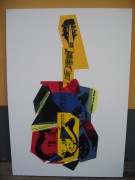 Vernissage midsommardagen 15-18. Utställningen pågår 20-21 samt 27-28 juni, kl 15-18 samtliga dagar.
Vernissage midsommardagen 15-18. Utställningen pågår 20-21 samt 27-28 juni, kl 15-18 samtliga dagar.
För mer info se bifogad pressrelease eller ring Ewa Wigenheim-Westman
070-5238933
På Volvos kapitalmarknadsdag i Eskilstuna under tisdagen berättade Volvos koncernchef Leif Johansson att koncernen utvecklat en egen medeltung motor för lastbilar och bussar som lanseras 2010. Vidare berättade han att fokus de närmaste åren kommer att riktas mot ökad intern effektivitet. Han konstaterade också att försäljningsutvecklingen för lastbilar fortsatt att försvagas under det andra kvartalet, något som också framgått av de siffror över lastbilsleveranser som koncernen presenterat under våren. Eftersom koncernen strävar efter att minska lagren av nya produkter är kapacitetsutnyttjandet i tillverkningen på mycket låga nivåer överlag i fabrikerna.
I sitt anförande sade Leif Johansson vidare att koncernen efter de senaste årens kraftiga tillväxt, som skett både genom förvärv och organisk tillväxt, nu har tillräcklig kritisk massa för att vara globalt konkurrenskraftig. Fokus de närmaste åren kommer mera att riktas mot att öka den interna effektiviteten, bland annat genom att dra fördel av synergivinster.
Leif Johansson berättade att Volvokoncernen utvecklar en egen, koncerngemensam plattform för medeltunga dieselmotorer. De nya medeltunga motorerna kommer att börja lanseras under 2010. Han konstaterade vidare att Volvokoncernens investeringar i forskning och utveckling kommer att ligga på fortsatt höga nivåer de närmaste åren eftersom ny emissionslagstiftning införs för lastbilar, bussar och anläggningsmaskiner. På sikt kommer de olika ländernas emissionslagstiftning att närma sig varandra och med en global teknikplattform finns det skalfördelar för Volvokoncernen inom såväl forskning och utveckling som inköp och produktion.
Leif Johansson talade också om betydelsen av att fortsätta utveckla kompletterande tjänster och tillbehör som stöder produkterna genom hela dess livscykel. De lastbilar och maskiner som är i drift behöver reservdelar, service och underhåll. Volvokoncernen har en stor population av produkter på de flesta marknader vilket är särskilt betydelsefullt i en lågkonjunktur då försäljningen av nya produkter är svag. Försäljningen av bland annat reservdelar, service, finansiering och andra tjänster har heller inte minskat i samma grad som försäljningen av nya produkter.
I sitt anförande kommenterade Leif Johansson även marknadsutvecklingen:
”Vi har ännu inte sett några tecken på att våra huvudmarknader i Europa och Nordamerika vänt upp, men möjligen har vi börjat se tecken på en utplaning. Vi arbetar hårt med att minska lagren av lastbilar och anläggningsmaskiner samtidigt som vi försöker försvara prisnivån. Mot bakgrund av den svaga efterfrågan i marknaden har vi dragit ned produktionen ytterligare jämfört med det första kvartalet. Till dess vi fått lagren och våra kostnader i balans med efterfrågan i marknaden kommer vi att ha fortsatt låg täckning av våra kostnader, vilket påverkar lönsamheten”, säger Leif Johansson.
Leif Johansson konstaterade också att Volvokoncernen i vissa länder, som till exempel Kina, Indien och Japan, märkt en viss uppgång, mycket tack vare statliga stimulansåtgärder.
Volvokoncernens finansdirektör Mikael Bratt berättade i sitt anförande om de åtgärder som genomförs runt om i Volvokoncernen för att sänka kostnadsnivån och förbättra kassaflödet. Han konstaterade också att Volvokoncernen, trots den mycket kraftiga nedgången har goda likviditetsreserver samtidigt som bolaget har en fördelaktig lånestruktur med få förfall under de närmaste två åren och att koncernen genom sin globala närvaro har goda möjligheter till upplåning på kapitalmarknaden.
Under de senaste tio åren har 355 personer omkommit i samband med fritidsbåtsolyckor. 284 personer eller åtta av tio skulle troligtvis ha överlev om de använt någon typ av flytväst. – Flytvästen är en billig livförsäkring. Förhoppningsvis kommer Sverige inom snart att följa andra länder där det enligt lag är båtförarens ansvar att det ska finnas godkända flytvästar till alla som är ombord på båten, säger Anders Wernesten, informationsansvarig på Svenska Livräddningssällskapet, SLS.
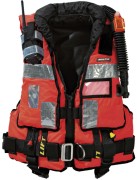 Tyvärr förbereder sig inte alla för en olycka där någon faller i vattnet eller tvingas hoppa överbord. Det finns säkert de som inte tycker sig ha råd att skaffa en flytväst. En flytväst är en billig livförsäkring och kan fås för 200 kronor och uppåt. Det går också att få låna en flytväst från någon av de fler än 300 flytvästdepåer som finns i Sverige.
Tyvärr förbereder sig inte alla för en olycka där någon faller i vattnet eller tvingas hoppa överbord. Det finns säkert de som inte tycker sig ha råd att skaffa en flytväst. En flytväst är en billig livförsäkring och kan fås för 200 kronor och uppåt. Det går också att få låna en flytväst från någon av de fler än 300 flytvästdepåer som finns i Sverige.
Vid fiske från stränder och klippor är västen också en bra trygghet. Små barn som leker i och vid vatten kan med fördel använda räddningsväst som en extra säkerhet, givetvis i kombination med ständig tillsyn.
När du köper flytväst, tänk efter hur den ska användas och vem som ska ha den på sig. Ta hänsyn till simkunnighet och vattenvana. Köp bara flytvästar som är CE-märkta, oavsett modell.
Män över 50 flyter dåligt
Den typiska båtolyckan sker när en man över 50 år ger sig ut ensamför att fiska. Båtturen sker i en liten sjö i lugnt väder. Mannen använder inte flytväst och är ensam när han faller överbord. Om mannen använt flytväst skulle hans överlevnadschanser ha ökat avsevärt.
Vi vet också från genomförda undersökningar att fler än 2 miljoner vuxna svenskar inte tror sig kunna simma 200 meter. De har dålig vattenvana och är i stort behov av flythjälp om de skulle hamna i vattnet.
Många turister är ovana vid våra svenska väder- och vattenförhållanden. Kunskap om behovet av flytväst och våra kalla vatten saknas ofta vilket leder till onödiga drunkningstillbud.
Livförsäkring att låna gratis
De som trots allt tycker att flytvästen är en kostsam investering för ett enstaka tillfälle kan få låna en. Svenska Livräddningssällskapet har medverkat till att det i Sverige finns fler än 300 flytvästdepåer över hela landet där det går att låna räddningsvästar gratis eller till en mycket låg kostnad.
Du kan få reda på var du kan låna flytväst genom att gå in på Svenska Livräddningssällskapets förteckning över flytvästdepåer på www.sls.a.se, eller kontakta Konsumentvägledningen i din kommun.
Norska Windy Boats stoppar produktionen till oktober i år. Företaget är Norges näst största båtproducent efter Askeladden. Det är den finansiella oron som påverkar Windy så kraftigt. Produktionen har minskat med cirka 40 procent jämfört med samma tid förra året, uppger den norska tidningen Praktiskt Båtlivs nätupplaga.
150 båtbyggare permitteras därmed från Windy.
– Vi befinner oss definitivt i ett utsatt och svårt läge. Övergångstiden från högkonjunkturens topp till den bottennivå vi nu är nere på är alltid svår och smärtsam. Folk i allmänhet och särskilt våra återförsäljare har därför svårt för att se hur framtiden kommer att bli. Detta har gjort att vi bestämt oss för att lägga vår produktion på en lägre nivå, säger Windys VD, Morten Haakstad till batliv.com.
Den enda avdelning som inte drabas av nedskräningarna är utvecklingsavdelningen. Där planeras flera modeller inför 2010 och 2011, bland annat Windys första superyacht.
Länk: www.windy.no
De 300 granitblock som Greenpeace i augusti förra året placerade ut på Sylts yttre rev, utanför den tyska Nordsjökusten, har stoppat både bottentrålning och grusutvinning i området. Det visar dokumentation från en dykexpedition som just nu genomförs för att utvärdera projektet.
– Vi kan konstatera att stenarna verkligen skyddar naturvärdena i det tyska Natura 2000-området, vilket är bra. Däremot är det tragiskt att vi måste lägga ut sten för att rädda områden som myndigheterna själva identifierat som skyddsvärda, säger Isadora Wronski, ansvarig för havsfrågor på Greenpeace.
Bildmaterialet från dykningarna utanför Tyskland visar att stenblocken, som företrädesvis kommer från halländska stenbrott, inte sjunkit ned i botten utan fortfarande fungerar som effektiva trålhinder. Dokumentationen visar också att stenarna nu blivit en naturlig del av ekosystemet och att de mindre än ett år efter att de placerats ut är täckta av djur och växter.
– Faktum är att den biologiska mångfalden har ökat. Det beror på att stenarna skapar mer hårdbotten, vilket är viktigt för att många arter ska kunna etablera sig, säger Isadora Wronski.
Marina skyddsområden i EU-ländernas vatten saknar idag i praktiken skydd från destruktivt fiske eftersom unionens regler ger väldigt begränsade möjligheter för nationella myndigheter i medlemsländerna att reglera fisket.
Grundproblemet är att fisket lyder under fiskelagstiftningen och havsmiljön under miljölagstiftningen. Det gör att lag står mot lag. I dagsläget är det alltid miljön som får ge efter för kortsiktiga fiskeintressen. Under Sveriges ordförandeskap i EU har regeringen en unik möjlighet att ta initiativ för en integrerad havsförvaltning inom ramen för den reform av EU:s gemensamma fiskeripolitik som nu initieras. Havsförvaltningen måste utgå från ekosystemansatsen, vilket innebär att även fisken i våra hav ska ses som en del av ekosystemet. Ansvaret för just EU:s havsfrågor tog Sverige över redan vid årsskiftet.
– Stenarna är en nödåtgärd. Vad vi behöver är lagar och regler som gör det möjligt att enkelt och effektivt skydda värdefull havsmiljö mot alla hot, inklusive destruktivt fiske. Idag saknar myndigheterna i alla EU-länder dessa verktyg. Därför måste Sverige arbeta för att ändra EU:s regelverk, säger Isadora Wronski.
Greenpeace har under året förberett utplacerandet av trålhinder i två svenska Natura 2000-områden, Fladen och Lilla Middelgrund utanför Hallandskusten. Nyligen konstaterade Länsstyrelsen i Halland att Greenpeace inte behöver ansöka om tillstånd för projektet eftersom det rör sig om en bevarandeåtgärd. Länsstyrelsen anser också att stenutplacering i Kattegatt inte kommer att påverka miljön i områdena negativt, vilket den tyska dokumentationen bekräftar.
Länk: www.Greenpeace.se
Under invigningen av den första Världshavsdagen 8 juni i år lanserade FAO, FN:s livsmedels- och jordbruksorganisation, riktlinjer för att minska fiskets inverkan på sårbara arter och ekosystem i djuphavet. Riktlinjerna kan användas av regeringar individuellt och inom ramen för regionella fiskeregimer för att förvalta djuphavsfisket (DSF) i öppna havet utanför nationella territorium.
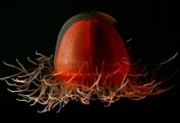 Många djuphavsfiskarter växer långsamt, når könsmognad sent och reproducerar inte årligen. Därför är de mindre motståndskraftiga och återhämtning från överfiske kan ta flera generationer.
Många djuphavsfiskarter växer långsamt, når könsmognad sent och reproducerar inte årligen. Därför är de mindre motståndskraftiga och återhämtning från överfiske kan ta flera generationer.
Riktlinjerna fastslår att allt fiske i djuphavert måste vara “rigoröst förvaltat”, och beskriver hur sårbara marina ekosystem ska identifieras och skyddas och hur vi kan nyttja resurser i djuphavet på ett hållbart sätt. Dokumentet ger också en översikt över hur lokalisering och bedömning av sårbara marina ekosystem, inklusive djuphavsfiskbestånd ska förbättras.
Fiskenationer ska utvärdera hur djuphavsfisket ser ut och identifiera eventuella negativa effekter av detta. Ett fiskestopp ska ske i områden där allvarliga effekter på sårbara ekosystem påvisas. Restaureringsåtgärder ska sättas in i sådana områden. Om det bedöms att djuphavsfiske kan fortgå på ett ansvarsfullt sätt ska metoder för att minimera negativa effekter vidtas.
Välbehövliga riktlinjer
Djuphavsfiske är ett relativt nytt fenomen och kräver avsevärda resurser i form av teknologi och investeringar. Därför har få länder infört regler och planer för hantering av denna aktivitet.
“Riktlinjerna tillhandahåller välbehövliga principer för hur djuphavsfiske kan ske på ett ansvarsfullt sätt och innbebär ett genombrott för integrering av miljö- och fiskefrågor”, säger Ichiro Nomura, undergeneraldirektör och chef för FAO’s avdelning för fiske och vattenbruk.
Riktlinjerna som publiceras idag antogs av FAO-medlemmar i Rom i september 2008.
Känsliga marina ekosystem
Djuphavsfiske i öppna havet hotar känsliga arter som koraller och svampar som inte är mål för verksamheten. Dessutom medför aktiviten risker för bottenmiljöer som utgör habitat för ömtåliga arter.
Djuphavet är världens största livsmiljö och står för runt 50 procent av jordens yta.
Världshavsdagen
Kanada tog inititativet till Världshavsdagen under Riokonferensen 1992. Allt fler länder, organisationer och individer använder dagen för att sprida medvetenhet om havens betydelse för allt liv på jorden. FN:s generalförsamling tog den 5 december 2008 ett formellt beslut om att FN:s Världshavsdag ska hållas 8 juni varje år.
FN:s iaktagande av Världshavsdagen samordnas av FN:s avdelning för oceaner och sjölagen tillsammans med UN Oceans, med inblandning av flera FN-organ inklusive FAO.
Temat för årets Världshavsdag är “Våra hav, vårt ansvar”.
EU satsar drygt 90 miljoner kronor för att fler forskare ska få arbeta vid Europas främsta forskningsstationer. I det unika nätverket ingår Göteborgs universitets marina laboratorier och fartyg vid Sven Lovén centrum för marina vetenskaper.
EU-projektet ASSEMBLE knyter samman Europas nio största marina forskningsenheter med forskningsstationer i Israel och Chile. Syftet är att samla den marina infrastrukturen och göra den tillgänglig för fler europiska forskare genom ett särskilt gästforskarprogram, där den första utlysningen just utannonserats.
Nätverket koordineras från Göteborgs universitets marina organisation Sven Lovén centrum för marina vetenskaper – vars forskningsstationer på Tjärnö i Strömstad och vid Kristineberg i Fiskebäckskil har en stark tradition av internationellt framgångsrika samarbeten.
Ett exempel är den norska forskningsgrupp som just nu befinner sig på Kristineberg för att studera den säregna kantnålsfisken, som tillhör samma familj som sjöhästen. Forskarna har visat att kantnålsfiskar ställer alla begrepp om hanliga och honliga roller på huvudet: här blir hanen gravid när honan med en “penis” för över äggen till honom, och under graviditeten får ynglen syre och näring via en “faderkaka”.
Ett annat exempel på gästforskarverksamhetens betydelse är de tidiga studier om bioluminescens, djurs förmåga att alstra ljus, som 2008 års Nobelpristagare i kemi Osamu Shimomura gjorde vid Kristineberg under 1960-talet.
– Genom att ingå i nätverket hoppas vi kunna bredda verksamheten och locka forskare även utanför marinbiologins fält, till exempel från bioteknologi och biomedicin, säger projektets koordinator Mike Thorndyke, professor i marinbiologi vid Göteborgs universitet och verksam vid Lovén-centret i Kristineberg.
Den marina forskningen är beroende av att stationerna kan tillhandahålla marina organismer, både på plats och via leverans. Därför avsätts en del av ASSEMBLE-projektets budget till att utveckla denna service, bland annat i form av ny experimentell utrustning för att karaktärisera arter. I detta samarbete ingår även kontakter med Sahlgrenska Akademiens Genomic Core Facility.
Länk: www.gu.se
Miljöminister Andreas Carlgren välkomnar den Östersjöstrategi som EU-kommissionen presenterade i Bryssel idag. Bland förslagen finns att Östersjön ska bli ett pilotområde i EU för havsmiljöåtgärder och att fosfater tas bort ur tvättmedel. – Det är hög tid att EU blir en betydande aktör för Östersjön. Vi är mycket nöjda med att få kommissionens tydliga besked om att Östersjön ska bli ett pilotområde i genomförandet av EU:s marina direktiv, säger miljöminister Andreas Carlgren.
Kommissionens strategi innehåller också följande förslag för att förbättra Östersjöns miljö:
Ett övergödningsmål om ökningen av fosfatrening till 0,5 mg/l, vilket innebär samma reningsgrad som i Sverige runt hela Östersjön. Detta stärker genomförandet av Östersjönländernas gemensamma aktionsplan för havsmiljön, Baltic Sea Action Plan.
Ta bort fosfater i tvättmedel. I första hand skall genomförandet i länderna runt Östersjön skyndas på. Sverige pekas också ut som så kallat lead country i fosfatfrågan och kommer att fortsätta att agera pådrivande för ett förbud i alla EU-länder.
Havsplanering ska utvecklas i hela Östersjöregionen. Östersjön kan därmed bli en föregångsregion för ett genomförande av EU:s maritima blåbok.
Åtgärder inom jordbruk och fiske förutses för att minska belastningen på havet. Östersjöstrategin ska skapa ett ramverk för förbättringar med åtgärder på kort sikt och genom att löpande uppföljning.
Mellan 2007 och 2013 kommer Östersjöregionen att tilldelas närmare 10 miljarder euro för miljösatsningar genom sammanhållningspolitiken och andra EU-medel.
– Vi ser fram emot att få agera som lead country för fosfatförbudet och för en bättre avloppsrening. Utifrån strategin kommer vi under det svenska ordförandeskapet att visa på Östersjön som ett exempel för hela EU om hur utvecklingen kan vändas i ett förgiftat hav. Sverige ska göra skillnad det kommande halvåret och samla den kraft som finns i EU för att rädda Östersjön, säger Andreas Carlgren.
EU:s Östersjöstrategi ska diskuteras vid ett särskilt möte för medlemsstaternas EU-ministrar i Stockholm den 17-18 september. Sverige kommer som ordförandeland att driva på ett snabbt antagande av EU:s Östersjöstrategi i samband med stats- och regeringschefernas möte den 29-30 oktober.
Enligt Svenska Livräddningssällskapets, SLS, preliminära sammanställning över omkomna genom drunkning visar att 6 personer omkom under maj i år jämfört med 9 personer under maj 2008. Totalt har 24 personer omkommit i år genom drunkning jämfört med 31 under 2008.
Här är den aktuellastatistiken:
2009 maj 2008
4 fritidsbåt 1
1 fritidsbåt, utländsk –
– dyk 2
1 övriga 4
– is 2
6 totalt 9
Kortfattad beskrivning av drunkningsolyckor under maj 2009.
8/5, Fritidsbåt
Fjällbacka, Gåsön, Florön, OP-län
En man 50-årsåldern saknas efter att båten grundstött på ett skär.
11/5, Fritidsbåt
Älmhult, Femlingen, G-län
En 67-årig tysk man som försvann under en kajaktur på sjön Femlingen har hittats död.
17/5, Fritidsbåt
Sollerön, Siljan, W-län
Två män 61 och 76 år var ute och fiskade när deras båt kapsejsade. Den 61-årige mannen har hittats drunknad, den äldre mannen är inte hittad.
22/5, Övriga
Jättendal, Hälsingland, X-län
En 1-årig pojke föll ner i en brunn och drunknade.
27/5, Fritidsbåt
Sandön, Luleå skärgård, BD-län
En 65-årig man avled när han med en mindre båt var på väg till en större båt ute i sjön. Han har av någon anledning fallit i vattnet, men det är oklart varför. Det blåste starka vindbyar på platsen.
Ostindiefararen lämnade på lördags kvällen Göteborg under klarblå himmel. Skeppet gör sommaren 2009 en skandinavisk turné med hamnstopp i Danmark, Norge och längsmed Sveriges västkust. Sommarens turné är uppdelad i fem etapper. Ombord finns, förutom den professionella besättningen, en jungmansbesättning om 50 män och kvinnor som byts ut efter varje etapp. Den första etappen går till Arendal på norska Sörlandskusten.
Till Sörlandskusten anländer Götheborg på midsommarafton den 19 juni för att vara del av den historiska folkfesten Kjaempestaden.
– Det glädjer oss att Götheborg är ute på turné igen och att vi kan genomföra turnén som planerat trots branden i Frihamnen, då vår lagerlokal brann ner. Nu hoppas vi att skeppet får en sommar med mycket segling och uppskattade hamnbesök i våra skandinaviska grannländer, säger Emanuel Persson, expeditionsledare på SOIC.
Innan färden går vidare till Arendal, stannar Götheborg till i Marstrand för att agera startskepp för Volvo Ocean Race den 14 juni.
Scandinavian Tour 2009
Klara hamnstopp:
Marstrand/Volvo Ocean Race 14 juni
Arendal 19-21 juni
Fredrikshamn 26-28 juni
Sandefjord 1-3 juli
Stavern 4-5 juli
Stavanger 15-17 juli
Lysekil 27-30 juli
Risör 6-9 augusti
Länk: www.soic.se
Ericsson 4 leder fältet i Volvo Ocean Race på väg mot Stockholm. Det har gått undan ganska bra under natten och nu återstår mindre än 200 Nm till målgången. Ericsson 3 ligger på tredje platsoch PUMA på andra plats. Det är dock oerhört tätt mellan båtarna i fältet, men med tanke på den tuffare navigering som väntar så kan “svenskbåtarna” ha ett försprång.
Här är de senaste uppgifterna från racets hemsida:
The news is encouraging from Telefonica Blue. Race Director Jack Lloyd, who was with Bouwe Bekking this morning in Marstrand where the boat underwent a full inspection overnight, reports that there is no major structural damage to the keel or the canting mechanism.
The main damage is to the daggerboard casing and the hull aft of the casing. The daggerboard took the brunt of the impact. The shore crew, led by Campbell Field, is working on a fix for that. There is some gouging of the keel bulb, which will be filled.
Apart from a few minor bruises, all the crew is in good shape and there is a positive mood in the camp.
Jack also reported that Ericsson Racing have made their workshop available for repairs and plenty of other team member have weighed in to help out.
The plan at this stage is to have the boat on the water by Wednesday or Thursday at the latest. Bekking’s intention is to resume racing with a view to making the start line for the Stockholm in-port race series.
07:15 GMT UPDATE
Small gaps are appearing on the leaderboard at the 07:00 GMT Position Report. PUMA is still stuck in an Ericsson sandwich, Ericsson 4 leading the shoe boat by a mile with the Nordics on Ericsson 3 holding third but now three miles adrift of their big brothers.
Telefonica Black leads the second string at +7 miles while Green Dragon (+8) has traded places with Delta Lloyd (+9). The deficit from first to last has grown by five miles since the last sched.
Now just over 200 miles to the finish. The Race Viewer shows them broad reaching in 18-20 knots.
06:45 GMT UPDATE
Given that the fleet is still rollicking along at 20 knots, revisions are being issued on ETAs. There is one light patch lying ahead, halfway along the Olund Island, which they are due to reach by 13:00 GMT.
If their progress is not unduly slowed by that dollop of light wind, which seems likely at this stage, then the ETA may be in the region of 21:00 GMT (23:00 local, Sweden). Further updates when we have them.
06:00 GMT UPDATE
We will bring the latest on the Telefonica Blue situation as soon as we have it. In the meantime, PUMA skipper Ken Read has sent his reaction to events at the start in Marstand where Bouwe Bekking’s men hit a rock, were stranded for two hours, suspended racing and are currently undergoing repairs in port.
“Telefonica’s collision with the rock is enough to make you sick to your stomach watching,” Read wrote. “A grotesque sight that you never want to see or be part of.
“We were following about 10 boat lengths behind T Blue in second place heading south when it happened. Capey (navigator Andrew Cape) was sitting next to me and saying that we were going to have to come up or down in the near future.
“We were going about 13 knots. And then … bang. Their (Telefonica Blue’s) entire transom came out of the water right in front of us. I said to Capey, ‘up or down!’, towhich he said up and we climbed off of the stricken boat by about three lengths and made it through.
“Bottom line is that no one wants to see something like that happen and for sure we are thrilled that no one was hurt. We hope they get back in the race by Stockholm. It just isn’t the same without the entire fleet together for the finish in St Petes.”
05:45 GMT UPDATE
We currently have a mountain of emails in from you, our avid online audience. I am going to do my best Edmund Hillary impersonation and bring you a taste of them throughout the morning. Apologies if you don’t make the cut.
Treat our liveblog email like a dart board. If you throw enough arrows you are bound to hit the bull’s-eye sooner or later.
05:40 GMT UPDATE
Mark Covell reports from the FleetBroadband Express that he has transmitted a load of video footage to our editing team here at Race HQ. That should take care of the rest of the morning’s viewing. Get the popcorn in.
05:30 GMT UPDATE
The emails from the Volvo Open 70 Media Crew Members are like big red buses … nothing for an hour, then three arrive at once.
This, just in, from PUMA’s Rick Deppe. “At 0500 GMT after crossing gybes with E4 for the last five hours, we are now side by side and headed north at pace, there are about 250 miles to he finish.
“Right now the thinking is that the wind will die out as we move north and the front that we have been playing will start to move away and we move into a high pressure system and a very different type of sailing.
“E3 are also right on our heels, let’s hope they don’t know something special about the area l or have some trick up their sleeve as we get closer to the coast and begin to play the sea breezes and coastal effects. It’s been a drag race up to now and that has suited us, the last 200 miles will be very tricky.”
Will the Nordics’ local knowledge play a hand in the outcome? We’ll see.
05:15 GMT UPDATE
There is a similar disregard for shut-eye on Delta Lloyd, so says Sander Pluijm. “We passed Green Dragon and Tel Black and made good gains on the rest, so after a rather disappointing day yesterday, this start of the day is better.
“The crew is eager not end up in the back of the fleet again so fighting spirits are high and sleeping hours low.”
05:00 GMT UPDATE
An email reaches us from the keyboard of Ericsson 3 Media Crew Member, Gustav Morin. Seems there are some bleary eyes among the Nordic crew. This leg may be a sprint, but sleep is at a premium.
Morin takes up the story … “I was just about to fall asleep behind the wheel”, Richard Mason says and put his head on the hatch in the aft when he comes up from emptying the water in the ballast tanks.
“His eyes are barely open and luckily he is about to take off to the his bunk. We have made pretty big gains on PUMA and Ericsson 4 during the night and morning. And we have increased the distance to Telefonica Black.
“We are still making good speed witht the big A4 gennaker up heading north-east towards Oland. It’s been a very fast trip so far and if the wind doesn’t drop we will, knock on wood, be ahead of the scheduled in to Sandhamn.”
04:45 GMT UPDATE
Thanks to the guys on the FleetBroadband Express for their eyewitness account of quite a boat race. By the 05:00 Position Report, we have a three-way stoush at the front featuring the Ericsson twins and PUMA.
And there is barely a crunchy nut corn flake between the second group of Delta Lloyd, Green Dragon and Telefonica Black. In fact, there is just four miles from first to last.
Just over 260 miles have been wiped off the clock, so another 260 remaining to the finish line in Sandhamn.
03:15 GMT UPDATE
Sorry for the delay. It was my turn at the wheel of the FleetBroadband Express. As I write this, we’re about a boatlength behind Ericsson 4, trying to keep up with them. The wind is up just over 15 knots, and the boats are doing speeds near 20 knots according to our GPS.
Ericsson 4 and PUMA have been trading gybes downwind this morning with PUMA the meat in an Ericsson sandwich. Magnus Olsson and the boys on Ericsson 3 aren’t far behind.
We’re just watching as Ericsson 4 sets up for a gybe. The process seems to start about 90 seconds to 2 minutes before they alter course. The sail stack on deck gets moved, the lines all set up for new heading, and then, finally, they swing the bow around. It almost looks more the the boat rotates under the sail than anything else. This particular gybe wasn’t the smoothest we’ve seen from Ericsson 4. Perhaps they had a bit of stagefright with us so close behind.
And Ian Moore, navigator Green Dragon, has just emailed in: “It’s daybreak and it looks like us and Delta Lloyd are bringing some pressure into the back of the fleet. We can now see then whole fleet and we have gained significantly on what we think is Tele Black. I think we just have more wind.”
02:00 GMT UPDATE
We’re up alongside PUMA now, who are leading the fleet on the charge north as the day breaks over Sweden. Great conditions out here, just around 12-14 knots of wind and PUMA sailing flat and fast with the spinnaker, staysail and full main up.
Not sure how much sleep the guys are getting on the race boats. Here, on the FleetBroadband Express, most are down below catching some rest.
Gustav Morin, Ericsson 3, says they’re trying to manage the sleep better on their boat. They think that was part of the problem last leg.
“We are trying to get some sleep and we have a couple of guys lying in their bunks on standbywatch, which means they are ready to go up for any manouvre. Last leg we think we lost a lot from pushing too hard with no sleep and everyone had a downtour at the same time whitch had a big effect on the decisionmaking. ‘The boat goes faster with more guys on deck, but only to a certain point, It is hard to find the balance,’ says Magnus Olsson and continues: ‘We are trying to be a bit smarter with the sleeping this time.'”
01:00 GMT UPDATE
Mark’s timing isn’t bad, I’ll give him that. This is Peter Rusch reporting now from the FleetBroadband Express, and just as Mark was getting ready to sign off, we spotted the masthead light of what we think is Ericsson 4. We’ve been charging along in an attempt to intercept the fleet as it closes with the coast.
If you ever want to gain an appreciation for just how fast the Volvo Open 70s are, just try to keep with them. It’s one thing to see them speed by during a leg start or in-port race. But it’s another thing again when you’re trying to stay with them for the long haul.
The sun is just starting to bleed light over the eastern horizon now, and I should think we’ll have a better idea of who were closing with over the next 30 minutes or so.
As Mark mentioned, our connection out here is good – thanks Inmarsat – but not quite what the guys have in the office. But keep the emails coming, and we’ll try to respond in kind. And over the next few hours, we’ll have some sunrise shots for you as well.
00:00 GMT UPDATE
Welcome to the Day 2 Live Blog. The eventful story of Day 1 is right here.
When we left the fleet they were all on port gybe and headed for Sandhammaren, on the south-east tip of Sweden. The breeze was a solid 20 knot westerly, and showing no signs of fading.
And not much has changed, everyone still blasting at the coast – the big tactical question being how close to go to the land. The further in you go, the more miles you save, but the more you risk running out of wind as you sail into the wind shadow of the land. A dilemma we will see played out in the next hour or two.
Krister just wanted me to know that you’re still out there, paying attention, despite the late hour. “I think you were wrong…” Krister goes on to point out that where I said at the 21:15 Update: The leaders have passed south of the light at Blenheim, and we now have a 15-to-18 knot westerly, it’s backed (rotated clockwise) from the north-northwest. The part in brackets should have been (rotated anti-clockwise). Nice spot, Krister.
Johan Carlsson reckons that, “we’re in for another late evening/night finish with the current ETA (estimated time of arrival) at around 23.35 tomorrow. The crews seem to have a pretty big appetite for leg finishes during the dark hours.”
And all the Arrivals team are grateful for it, Johan, they just love those long vigils into the night. I should point out that the ETA is posted in the Data Centre – it’s the variable called ARRIVAL.
Telefonica Black’s navigator, Roger Nilson has just emailed us on that very topic, “One weather model has us running to Olands Sodra Udde and then reaching home fast, finishing in the evening [ED – the one we’re using in the Data Centre]. The other model is a bit more complex with little wind around Gotland tomorrow and arrival in Sandhamn early morning Tuesday.”
As I was saying, long vigils into the night. And talking of long vigils into the night, with the fleet headed for the coast somewhere near the Sandhammaren lighthouse, now less than 20 miles away, the FleetBroadband Express has gone on ahead to try and intercept them. They should pick them up sometime around 01:00 GMT. So this is Mark Chisnell signing off and heading for bed, leaving Peter Rusch to pick up the story from the water once the fleet hit the coast.
Conditions are pretty rough out there, with wind speeds up and over 20 knots, so the rather tougher working conditions will make it difficult for Pete to respond to your emails. But the ‘full service’ blog will be resumed when Cameron Kelleher returns for the dawn patrol in the morning.
In the meantime, thanks for all the messages, it’s been a blast, and I’ll see you tomorrow afternoon.
Follow us on Twitter right here. And you can also link to it directly from your mobile via the top of the mobile channel.
Länk: www.volvooceanrace.org
Sonim Technologies, tillverkarna av världens mest stryktåliga och extrema mobiltelefoner lanserar sin nya och stryktåliga mobilmodell XP3.20 Quest med IP67-klassificering och funktioner som GPS, kamera, FM-radio, ficklampa och riktigt bra batteritid.
Släpp den från två meter rakt ner i betong, prata 18 timmar i sträck, dränk den i vatten, lämna den ute i -20 till +55 grader, täck den med damm eller lämna den på motorvägen.
Sonim XP Quest har genomgått Sonims hårda testutveckling ”Rugged Performance Program” (RPS) utvecklat för att säkerställa en hög standard för telefoner byggda för tuffa förhållanden och med minimal tillgång till el. Sonim XP Quest har förstärkts ytterligare och klarar nu ännu mer stryk än sina föregångare. Exempelvis har Sonim XP Quest:
• Högpresterande lithium-ion batteri som ger 1500 timmar standby och upp till 18 timmars taltid. Passande för exempelvis friluftsentusiaster och båtmänniskor som ofta har långt till närmaste elkälla.
• Utrustad med en anpassad bred knappsats testad för att klara upp till 500,000
knapptryckningar. Detta möjliggör exempelvis för byggarbetare att ringa utan att ta av sig handskarna.
• Kraftfulla högtalare som ger en signal på upp till 110db, 45 % mer än en vad en mobiltelefon normalt sett brukar avge. Till exempel kan ambulanspersonal ringa efter assistans trots högljudda sirener.
Sonim XP Quest överlever ett fall på två meter även om underlaget är av betong, att vara nedsänkt i vatten i upp till 30 minuter och temperaturer på -20 till +55 grader. Mobilen har repfri safirglasdisplay och är militärklassad enligt MIL-810F certifiering mot fukt, salt, transport och värme. Den är utrustad med en 2MP kamera med inbyggd blixt, assisterande GPS, ficklampa, FM-radio, minneskortplats för 2GB minne, J2ME Java-stöd för mobil, Opera mini webbläsare och Bluetooth.
Senare i sommar kommer Sonim erbjuda speciella Quest telefoner optimerade för att kommunicera över mobilnätet med hjälp av Push-to-talk teknik (PoC). Detta kommer att möjliggöra användning av mobilen på samma sätt som en komradio som exempelvis anställda vid en byggarbetsplats kan ha stor nytta av.
– Precis som alla andra Sonimtelefoner kommer Sonim XP Quest med en treårig villkorslös garanti. Om något skulle gå sönder byter vi ut den samma dag. Vi har definierat och satt upp hårda kriterier för stryktålighet, allt för att säkra att alla våra telefoner klarar tuffa förhållanden och är användbara i extrema situationer, säger Bob Plaschke, VD på Sonim.
Sonim XP Quest är kompatibel med ett stort utbud av färdiga biltillbehör, olika headsets och levereras med bältesklämma, laddare och headset.
Mobiltelefonen finns inom kort i butik i Sverige och kommer att säljas med operatörerna
Vodafone and Orange. Återförsäljare i Sverige är Dialect, Expert, RingUp, StrjärnFyrkant, Svenska Foder, Telia, och The Phone House. Priset beräknas bli ca 4000 SEK.
Sonims “Rugged Performance Standard” inkluderar:
1. Batteri med extra lång livslängd
2. Slitstarka tangenter
3. Extra kraftfull högtalare
4. Skydd mot damm och mikropartiklar
5. Skydd mot vatten
6. Skydd mot fall
7. Skydd mot stötar och vibrationer
8. Skydd mot extrem temperatur
9. Resistent mot extremt tryck
10. Resistent mot punktering (?)
11. Resistent mot olja
12. Tre års villkorslös garanti
Länk: www.sonimxp3.com
Det är mycket dramatiska bilder som kommer till oss från Volvo Ocean Races pressavdelning. På bilderna av Telefónica Blues grundstötning syns tydligt hur hårt båten står ordentligt på en enmetersgrynna och hur olikafartyg och båtar närmarsig för att bistå. Bilderna är också talande bevis för hur mycket svårare det är att navigera i svensk skärgård än på öppna oceanen.
Spanska Telefónica Blue har dragit sig tillbaka från vidare tävlan i det här legget. Skepparen – Bouwe Bekking – kallar det inträffade “en katastrof” och vi får se hur det går för båten i de återstående tävlingsmomenten.
Starten har gått! Ska Ola Skinnarmo bli förste svensk som lyckas segla genom Nordostpassagen, sedan Nordenskiöld för 130 år sedan? Trots global uppvärmning ger ryska experter Ola bara 50 procents chans. Vintern har varit kall och våren sen. Gott om is med andra ord.
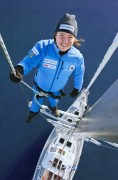 På måndagen satte han och hans besättning segel och lämnade kajen vid Kastellholmen i Stockholm för att påbörja ett äventyr som enligt planerna ska pågå i cirka tre månader. Den 6 000 sjömil långa seglatsen avslutas inte förrän i Berings Sund mellan Ryssland och Alaska. Ola själv anser att detta är den svåraste expedition han har genomfört
På måndagen satte han och hans besättning segel och lämnade kajen vid Kastellholmen i Stockholm för att påbörja ett äventyr som enligt planerna ska pågå i cirka tre månader. Den 6 000 sjömil långa seglatsen avslutas inte förrän i Berings Sund mellan Ryssland och Alaska. Ola själv anser att detta är den svåraste expedition han har genomfört
− Isen i Arktis kan vara mycket lömsk och i år ser det ut att vara extra tufft. Det finns helt klart en risk att båten skruvas ner eller att vi likt Nordenskiöld tvingas övervintra i ismassorna. Men faktum är att på grund av den globala uppvärmningen är isen mycket tunn och spröd och till stor del endast ettårig, så den kan försvinna snabbt när sommaren kommer, säger Ola Skinnarmo.
Expeditionen genomförs i samarbete med Världsnaturfonden, som kommer att finnas med ombord. Bland annat ska man studera hur glaciärerna har förändrats, samt livsbetingelserna för människor och djur i de arktiska områdena.
Seglingen går först runt Sveriges kust upp till Göteborg, sedan via Oslo och Tromsö till Svalbard, där expeditionen kommer att besöka forskare och ta del av färska data kring den globala uppvärmningens konsekvenser. I början av augusti är det dags att avsegla mot Murmansk och sedan börjar det verkliga äventyret – Nordostpassagen. Om de 50 procenten är på Olas sida så når expeditionen fram till Berings Sund i september. Några highlights från äventyret:
• 15 juni Stockholm. Start från Skeppsbron.
• 17 juni Karlskrina
• 18 juni Malmö
• 22 juni Göteborg. Samma dag som Nordenskiöld lämnade Karlskrona
• 24 juni Oslo, segling längs Norges kust mot Tromsö, ankomst 3 juli
• 5 juli mot Svalbard. Utforska södra Svalbard och träffa forskare.
• Början av augusti, Murmansk. Här startar Nordostpassagen på riktigt.
• Dickson, by namngiven av Nordenskiöld.
• Kap Tjeluskin, gamla värdens nordligaste punkt.
• Wrangelön, känd eller kanske ökänd för alla sina isbjörnar.
• Tjukotka, område där WWF jobbar tillsammans med isbjörnspatrullen.
• Någon gång i september avslutas expeditionen i Provedynja.
Länk: www.skinnarmo.com
Kommentarer
Ger honom inte stor chans, massor av is just nu längs rutten han har tänkt sig. Han gav ju upp i Antarktis så fort han förfrös tummen, så han vågar sig väl inte så långt innan han vänder. Förra året var det en galen britt som försökte paddla till Nordpolen, inte en chans fick ge upp nästa direkt, och så Catlin expeditinen i våras, under minus 30 grader i 2 månader i sträck, nej de kom inte heller i närheten av Nordpolen…
Ola lycka till du behöver det!
Kane, det var Göran Kropp som avbröt när han och Skinnarmo skidade tilsammans mot nordpolen. När Göran blev räddad fortsatte Ola själv de restrerande 50 milen till Nordpolen!
Visst jag hade för bråttom helt korrekt, men det blir tufft hur som helst, följde Catlin expeditionen under våren, det var en stentuff kamp för överlevnad inget annat.
Är det ingen mer än jag som funderat på hur det kan komma sig att Nordenskjöld kunde ta sig igenom redan 1880. Då hade ju inte den av människan orsakade växthuseffekten börjat och ändå var det så lite is. Eller fanns det SUVar redan då? 🙂
Heja heja Ola!!! han är ett föredöme och en inspiration – äntligen ett äventyr med hjärta och hjärna.
Tror ju inte för en sekund på att han kommer klara det, men lycka till!
Ericsson 4 med skepparen Torben Grael är klar totalsegrare i Volvo Ocean Race 2008-2009. Det stod klart några minuter innan kl. 23 på måndagskvällen då den mest rafflande delsträckan hittills avgjordes. Segrare blev PUMA, som korsade mållinjen bara ett hundratal meter innan Ericsson 3 med Mange Olsson som skeppare kom i mål.
Det såg länge ut som om Ericsson 3 skulle kunna vinna delsträckan och därmed ta en stor prestigevinst på hemmaplan. Men PUMA kämpade väldigt starkt och efter ett Ericsson 3 fått problem med att storseglet fastnade i radarantennen tog sig PUMA förbi och vann sträckan.
Ericsson 4 behövde egentligen “bara” ta sig i mål, men kämpade mycket starkt och kom alltså trea på sträckan.
Spanska Telefónica Blue gjorde en riktigt bra inledning av leg nio vid dagens start i Marstrand. Men båten med skeppare Bouwe Bekking gick på grund direkt efter starten och stod hårt på en klippa när hjälpen kom fram. Händelsen inträffade vid 14 knops fart, då Telefónica Blue träffade en grynna som låg på en meters djup. Telefónica Blue kom dock senare loss och är med i racet.
Efter grundstötningen tog teamet ombord på Telefónica Blue omedelbart ner seglen, men båten stod ändå fast förankrad på den bohuslänska berggrunden. En lotsbåt och en Kustbevakningsbåt fanns i närheten för att bistå besättningen. Alla ombord var dock oskadda efter intermezzot.
Telefónica Blue tog starten före PUMA med skepparen Ken Read som därefter slog och gick upp i ledningen. PUMA var dock nära att träffa ett grund eftersom båten slog bara några meter från en annan grynna.
Vid åttatiden på söndagskvällen – med 422 Nm kvar till Stockholm – ledde PUMA med 3 Nm över tvåan, Ericsson 4. Ericsson 3 låg då på fjärde plats, 4 Nm efter ledaren. Racet mot Stockholm ser därmed ut att bli oerhört jämnt.
Om söndagens friska vindar håller i sig kan det gå undan ordentligt på väg mot huvudstaden. Vägval och rutin av skärgårdsnavigering kan bli helt avgörande, vilket talar för en svensk delseger. Men med Roger Nilson som navigatör på Telefónica Black (trea på söndagskvällen) kan det bli en rafflande tillställning.
Här är resten av pressreleasen om starten:
Ian Walker took Green Dragon in to a very light patch of breeze immediately after the start and the crew unfurled their enormous code zero fleet as they headed towards the spectator fleet on the right hand side of the course.
Out on the left, PUMA and Delta Lloyd had plenty of wind and for the first 20 minutes of this inshore lap, the left side of the course continued to pay very well, but the breeze was dying all the way across the racecourse.
A big lumpy swell made it difficult for the teams drive the boats in just five to six knots of wind and it was painful to watch as the boats came to a shuddering halt on every wave. The new breeze, when it came, filled in on the right hand side of the course and Green Dragon with the luck of the Irish, and had the first taster of the eight or nine knots of breeze, giving them the advantage in the approach to the first turning mark.
They took the lead followed one boat length behind by Telefónica Blue. PUMA and Ericsson 3 made up the top four, while Telefónica Black, Delta Lloyd and, unusually, Torben Grael and Ericsson 4 were the second string.
Racing downwind, the top three boats hoisted spinnakers, while the chasing pack stayed with their massive code zero headsails. Enthusiastic race goers invaded the racecourse and PUMA sailed downwind escorted by a big spectator fleet.
By the time the leading four had reached the final turning mark, the order had changed again and there was action and drama aplenty. Green Dragon had stayed out to the left of the course, nearest the spectator fleet, but the wind filled in from the right, causing them to lose their lead and allowing Telefónica Blue, Ericsson 3 and PUMA all to reach the mark ahead.
Rounding the mark, Telefónica Blue showed a clean set of heels, while Ericsson 3 caught their spinnaker on their spreaders, which rendered them dead in the water. PUMA powered in and quickly took the opportunity to nip between Ericsson 3 and the mark, as Ericsson 3 wallowed and the crew tried to sort out the mess.
Meanwhile, Green Dragon approached at speed, and sailed inside both Ericsson 3 and PUMA. They were not able to establish their position and it was Telefónica Blue, who led the fleet out into the Kattegat from archrival PUMA, Ericsson 3 and Green Dragon, until disaster struck and the boat struck the rock.
This is the second time that such a disaster has befallen Telefónica Blue. The team struck a rock in Qingdao just before the start of leg five and the boat had to return to Qingdao to be hauled out for damage inspection.
As this press release is closed efforts continue to tow the yacht free from the rocks before the more serious damage is done.
Telefónica Black sailed a solid race to hold off Delta Lloyd, while Ericsson 4 remained mysteriously at the back of the fleet having also had a poor spinnaker drop at the leeward mark.
The 525 leg nine is expected to finish in Stockholm on Tuesday.
Overall Leaderboard
1. Ericsson 4 (Torben Grael/BRA): 102 points
2. PUMA (Ken Read/USA): 87.0 points
3. Telefónica Blue (Bouwe Bekking/NED): 86.0 points
4. Ericsson 3 (Magnus Olsson/SWE): 64.5 points
5. Green Dragon (Ian Walker/GBR): 59.0 points
6. Telefónica Black (Fernando Echávarri/ESP): 42.0
7. Delta Lloyd (Roberto Bermudez/ESP): 35.0 points
8. Team Russia (Andreas Hanakamp/AUT): 10.5 points
Länk: www.volvooceanrace.org

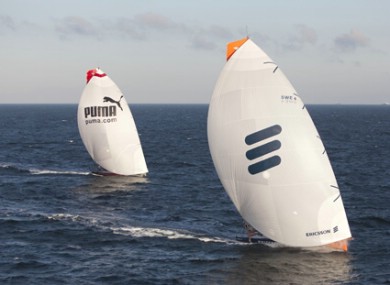
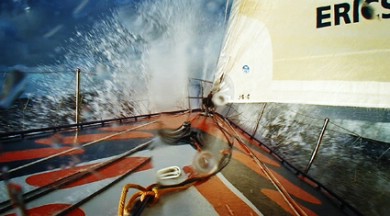
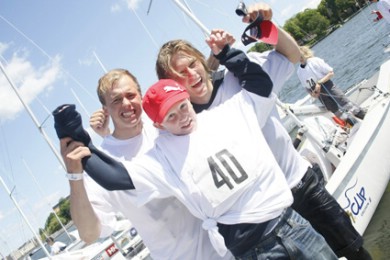

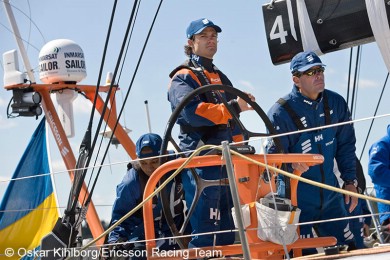







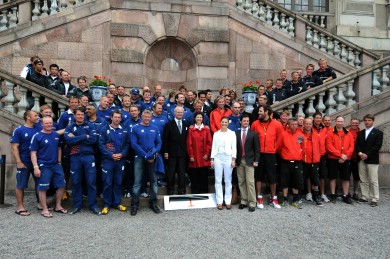
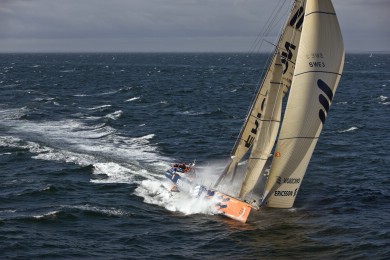




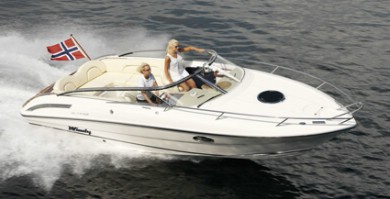
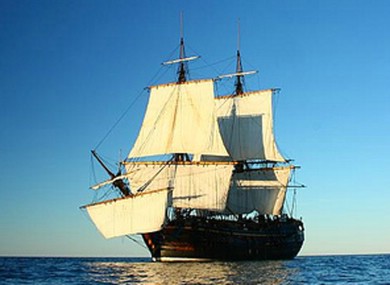
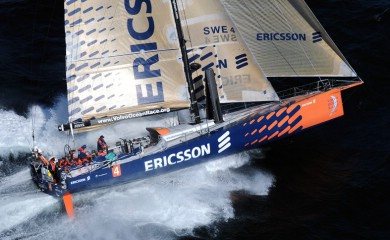

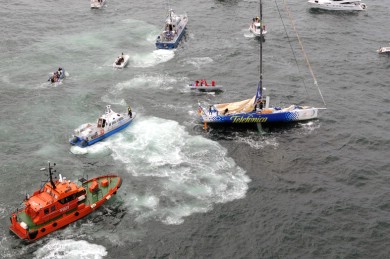





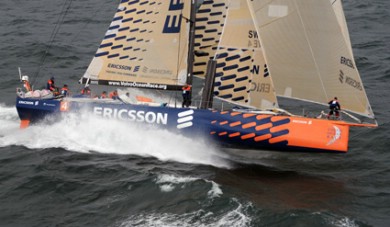


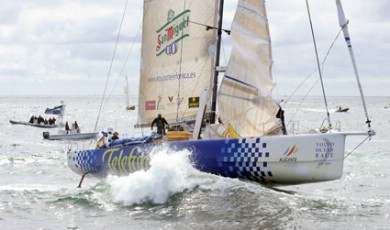







Kommentarer
får dom bryta helt?